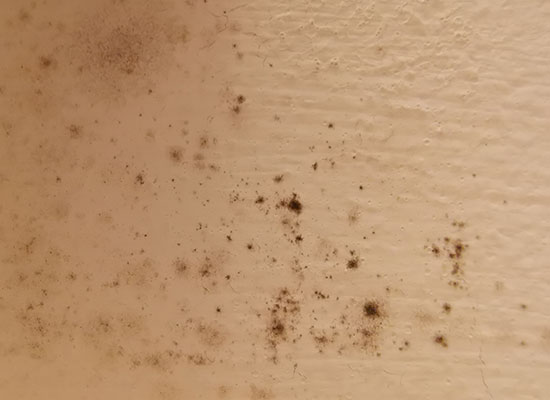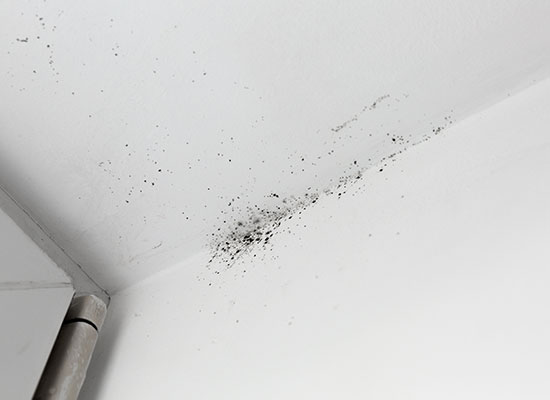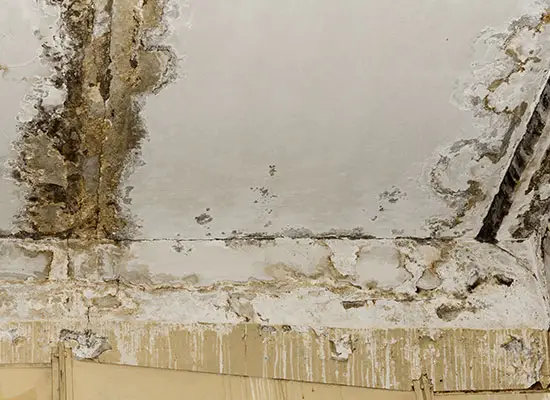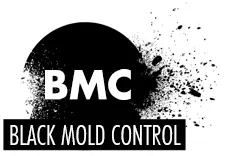Black mold on any ceiling can pose expensive and deadly risks to your home and family. For that matter, what exactly causes black mold? How can it go from tiny, almost minuscule spots to a problem that threatens to overtake areas like the bedroom, bathroom and other key parts of your home?

What causes black mold on ceiling?
The answers lie behind the most common culprits of this potentially dangerous fungal growth. The culprits themselves relate to how much water gets inside of your home and in what manner it is introduced to any ceiling or the materials, such as popcorn or wood, that cover them.
Humidity
For example, humidity may be thought of as a rather benign environmental inconvenience that you must contend with during the hottest months of summer. However, it can also lead to black mold growing on the ceiling in key areas of the home, such as the bedroom, bathroom and garage. If it gets excessively humid outside, the moisture can seep its way into your home and dampen ceiling materials like wood, popcorn or tile. The moisture in these materials cause conditions that are ideal for mold spores to take root, grow and cause tiny to large and very noticeable spots.
Leaks
Further, water leaks can also cause spots of black mold to take root. Leaks from the pipes in walls and floors can erupt and cause water to gush out to the ceiling. Along with causing ugly water spots in the bathroom, garage, bedrooms and other areas, the water leaks can cause detrimental and expensive spots of mold to grow.
By appreciating these two main culprits, you can act in defense of your home. You can also know what spots on the ceiling to scrutinize closely, particularly when you want to stop black mold from growing uncontrolled and threatening the health and value of your home and family.
Where to find black mold on ceiling?
This information can also compel you to pay more attention to the various ceilings, even those in the closet and shower, throughout your home. You can appreciate the importance of not overlooking the appearance and integrity of any ceiling in the house, regardless of where it is located and to what elements that it may or may not have been exposed.
Bathroom ceiling
The bathroom ceiling is arguably one of the most vulnerable to fungal growth like black mold. It is exposed repeatedly, day after day, not only to water from when family members shower but also heat or humidity from the shower that causes black mold to grow and thrive.
To find spots of black mold in the bathroom, you especially need to look above the shower and in the linen or medicine closet. Black mold may not grow as easily out in the center part of the bathroom or shower ceiling that is exposed to light, which can kill the spores. Instead, the spots of black mold thrive better in the corners of the shower and in the darkness of the linen or medicine closet in the bathroom. Recommended article: How to get rid of black mold in bathroom
Shower ceiling
As mentioned, the shower ceiling can be the ideal place for spots of black mold and fungus to take root and grow. The heat from the water rises to the shower ceiling. The ceiling also is exposed to lingering moisture, particularly if there is no fan in the bathroom to disperse the humidity.
To ensure that your shower ceiling does not grow spots of mold, you need to inspect it closely, especially in the corners and crevices. Black mold likes to hide in tight, dark areas, such as those found in corners, where it can thrive and spread quickly to other parts of your home.
Recommended article: Black mold in shower
Bedroom ceiling
Even areas away from the bathroom can be susceptible to this dangerous fungal growth. Especially if the ceiling in your bedroom is made from material like drywall or popcorn, it can be porous enough to retain moisture and water that leak from the window or come in from other parts of the home like the garage or bathroom.
As in the bathroom, you need to look in the dark corners and crevices for this fungus. You also need to inspect any closets that you have in the bedroom to make sure that there are no spots of fungus on them.
Recommended article: Black mold in bedroom

Garage ceiling
The garage ceiling likewise can develop ugly spots of fungal growth. The constant opening and closing of the garage door lets in moisture and water. Humidity from the outside also can seep into the drywall on the ceiling and walls where it can cause fungal spores to take root, thrive and spread easily.
While it can be easy for you to forget your garage when inspecting your home for mold, you need to look at its ceiling often for any signs of darkening or black spots. Instead of assuming that these spots are grease or oil stains, you need to inspect them closely to make sure that they are not actually burgeoning fungal colonies.
Recommended article: Black mold in garage
Closet ceiling
Finally, the closet ceiling can create the ideal conditions for black mold to take root and grow. Closets are often dark and closed away from the rest of the house. Elements like fresh air and light cannot get into them easily.
This type of dangerous fungus thrives in such conditions, however, and can creep into the closet, take root and spread and grow. When you inspect the closet for this fungus, you can look in the crevices and corners. However, because there is often a lack of fresh, circulating air in there, you can also rely on your sense of smell. If the closet smells dank, wet or like mildew, you can assume that there is fungus growing somewhere within it.
How to get rid of black mold on ceiling
Once you know the causes and ideal conditions of this expensive and detrimental fungus, you can act quickly to get rid of it. It is imperative that you clean and remove it thoroughly to prevent existing colonies from continuing to grow. You can also prevent spores from traveling from room to room in your home and causing other areas to suffer from this problem.
Clean and remove from ceiling tile
To get rid of it on ceiling tile, you may need to use housecleaning products that contain bleach or ammonia. However, you also need to remember to use safety goggles, a respirator mask and rubber gloves when you try to remove it from the tiles. You need to avoid letting the chemicals and spores get into your eyes, nose and mouth and in contact with your skin.
You also may need to use a wire or abrasive brush or sponge, depending on the texture and appearance of the drywall, wood or other material from which the tile is made. Scrub vigorously to loosen the spores and get rid of it from the tiles. Spray or rinse with the bleach or ammonia water and dry the tiles thoroughly.
Clean and remove from wood ceiling
Cleaning wood can be more challenging. Depending on how porous the wood is, you may need to use a sponge or brush that perhaps is not as saturated with cleaning products as those that you use on other materials. Still, you need to use the same vigor and muscle power to loosen and remove the spores.
You also need to clean the wood in a well-ventilated area to ensure that they dry out quickly. It is imperative that you do not allow the wood to remain wet, especially if they are not treated and porous. Fungus will continue to grow in them otherwise.
Recommended article: Black mold on wood
Clean and remove from popcorn ceiling
Cleaning a popcorn ceiling can be especially challenging and take great skills. You need to get rid of the fungal growth without loosening this material and causing it to fall on the floor.
To get rid of it, you can try using a soft sponge that you soak or dip in diluted bleach. It may not be advisable to use ammonia if you want to avoid the possibility of staining the ceiling.
You also may need to spend more time washing this type of material. You cannot use the same vigor to scrub and wash it as you would other materials. Still, with time and close attention, you can rid the popcorn of fungus.

Clean and remove from drywall ceiling
Finally, you can clean a drywall ceiling by using soft materials like towels or sponges. This material is like wood in that it is porous and somewhat fragile. You need to work in a well-ventilated area and make sure that there is plenty of light and air moving in the room.
It can also help you to aim a fan at the ceiling to prevent water from the cleaning job from soaking into the drywall. At the same time, however, you can benefit from running an air purifier to absorb mold spores that are released into the air. Recommended article: How to remove black mold from drywall
Remediation
Finally, if your cleaning efforts fail, you can always use remediation to get rid of black mold. Professional remediation technicians use a step-by-step process to lower the amount of black mold in your home’s ceilings. They can eliminate this fungus quickly, typically in a matter of days. They can also provide quotes and billing to homeowners insurance companies to spare clients the bill of their services.
Black mold can easily take root in your home’s ceilings and cause serious damages like health risks and depreciated values. You can act in your home’s best defense by learning what causes black mold, how to find it and what steps to take to get rid of it.
